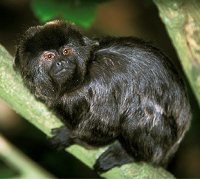Goeldi's monkeys (Callimico goeldii), spend up to 29% of their feeding time year-round consuming fungal sporocarps, the fruiting bodies of fungi.
We provide comprehensive data on the nutritional characteristics of 4 species of fungi consumed by Callimico goeldii (Ascopolyporus polyporoides, Ascopolyporus polychrous, Auricularia auricula, and Auricularia delicata). The composition of the fungi is similar to that of other fungi: predominantly fiber (66.283.0% dry matter) with small amounts of sugar (2.05.6% dry matter) and crude fat (0.91.6% dry matter). Though the crude protein content is substantial (5.513.4% dry matter), much of the nitrogen in the fungi is not likely to be available to Callimico goeldii because it is associated with indigestible food components or is in nonprotein form. The mineral content of the fungi are within the normal range for fungi generally and the calcium-to-phosphorus ratio is low (0.070.25). Fungi appear to be a low-quality food resource for Callimico goeldii and may contribute to their relatively large home ranges and low population density compared to other Callitrichinae. Research on the ability of Callimico goeldii to digest fungi is needed to understand fully the nutritional value of fungi to them. We discuss adaptations Callimico goeldii may have for improving their ability to obtain nutrients from fungi and potential ecological correlates of mycophagy.
Composition and Nutritional Characteristics of Fungi Consumed by Callimico goeldii in Pando, Bolivia
29augustus2006
Though ≥22 species of Primates consume fungi, most do so at low rates, comprising <5% of their feeding time.
